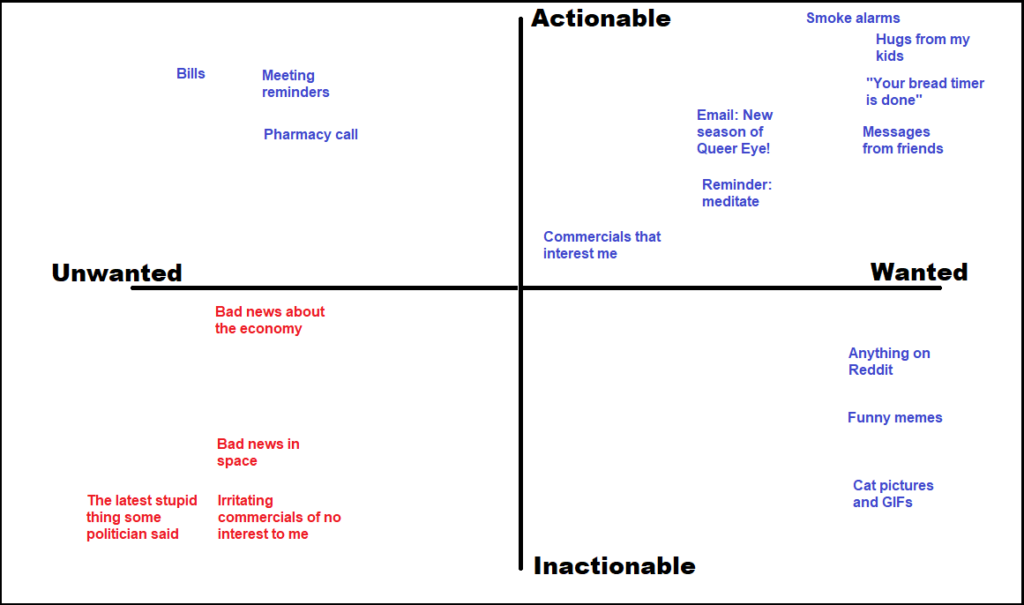Here’s the TL;DR (“too long; didn’t read” summary):
- In our personal AND professional lives, hundreds to thousands of things compete for our attention.
- We can sort these onto an X-Y graph of wanted to unwanted, and actionable to unactionable.
- Unwanted, unactionable attention-grabbers suck and should be eliminated as much as possible.
Things that get our attention
 In our personal AND professional lives, hundreds to thousands of things compete for our attention. For want of a better term, I call these things alerts. So of course, the constant influx of alerts is real-life alert storming. We are so inundated with things that grab your attention, it’s easy to become sidetracked down a dozen rabbit holes1, forget what you’re doing, and ignore what’s important.
In our personal AND professional lives, hundreds to thousands of things compete for our attention. For want of a better term, I call these things alerts. So of course, the constant influx of alerts is real-life alert storming. We are so inundated with things that grab your attention, it’s easy to become sidetracked down a dozen rabbit holes1, forget what you’re doing, and ignore what’s important.
Sorting alerts
One of the ways to fight back against real-life alert storming is to divide them up into categories: wanted vs. unwanted, and actionable vs. inactionable.
I like graphs and grids, so here’s an example of a Wanted/Actionable grid2 that’s specific to me:
The important focus (“Yep!”)
The most important alerts are things in that top-right box. Those are alerts that (A) I want to spend my attention on, and (B) I should really do something about. This category includes:
- friends who are trying to contact me,
- reminders of upcoming meetings and appointments,
- my kids (when they need or want something),
- blaring smoke alarms,
- and so on.
While some of these things are less fun than others, they are all things I am motivated to deal with. And, they’re all actionable: if a friend is reaching out, I write them back. If an appointment is coming up, I prepare. And again, so on.
Less important alerts (“Sure / I Guess I Gotta”)
Roughly tied for second place are those items that are wanted but inactionable (lower right square); and those that are unwanted but actionable (upper left). What do I mean by this?
- I want to see cute animal GIFs, but I don’t have to do anything about them. They’re wanted, yet totally inactionable.
- I don’t want to see a bill come in the mail, but I really really should do something about the stupid thing. Unwanted, yet actionable.
Brain-sucking alerts (“UGH NO”)
The last square – unwanted-inactionble – is dedicated to those alerts that I have zero interest in, and nothing whatever to do about them. These are the absolute time wasters, mood-ruiners, and work derailers.
Just a few examples:
- commercials on YouTube,
- junk mail,
- infinite alerts from my language learning software,
- and about a zillion others
You can call this category anything you like, but “brain-sucking alerts” has a certain accuracy about it.
Sorting our virtual life
I find that I naturally sort “real life” alerts into these categories. But when you live a lot of your mental life online (as I do), the lines become blurred quickly.
Let’s take Twitter as an example of this. I use Twitter to stay in contact with tons of friends and colleagues, to get a lot of my news, to keep up with industry updates, and so on. But, like any non-homogenous media3, a lot of what I see feels like it’s actionable, or looks like I’d want to read it…when in truth, it’s in the brain-sucking, “I hate it and I can’t do anything with it” category.
Do I need to see this same ad for this meat-based product that I, as a non-meat-eater, will never ever use? No. No, I do not. UGH.
Do I really want or need to know the latest stupid thing Celebrity ABC said? No. Is there anything I should do about it? Also no. UGH.
It’s a hard week for me, emotionally. Do I really want to see pictures and videos of [horribly infuriating thing here]? No. Is there anything I can do about it? Directly, no. Indirectly, maybe – via activism or awareness campaigns – but I’ve already done it AND/OR I don’t have the bandwidth right now4.
Those useless, disguised alerts are sneaky and insidious. They feel important. They look like things you would want to read. They might seem actionable. But in truth, they are by definition not in line with your current goals. And they are EVERYWHERE.
There are a half a hundred ways to reduce the number of brain-sucking alerts in your virtual life – from muting words, to blocking, to filters, and so on – but right now, I’d like to move on to….
Sorting the IT life
These same principles apply to the professional life, and of course, to IT work. Alert storming in IT tends to take the form of hundreds (or thousands!) of daily email alerts…none of which are wanted, and nearly all of which are inactionable. In technology work, these brain-sucking alerts aren’t just irritating and distracting; they can mask real, critical alerts.
An IT worker who receives tons of these useless alerts learns to ignore them. Either they delete them en masse, or set up mailbox filters to send them directly to the trash.
The IT solution to alert storming is relatively simple:
- Create email addresses for specific groups (e.g., helpdesk@co.com, sql@co.com, and so on) and use them appropriately.
- ONLY send actionable alerts. No more Job XYZ completed successfully “alerts”!
- Use smart alerting with Minion Enterprise. That way, SQL Server alerts are consolidated, and you can easily defer alerts and make exceptions.
In conclusion…
You decide what’s important. You decide what really needs your attention. Taming your alert storm is an ongoing process, and it’s absolutely necessary to regain your focus.
______________________
Footnotes:
1I love a mixed metaphor.
2If you like this, you’ll love the Eisenhower Matrix.
3Like books. Books are homogenous media.
4I have civic duties, yes I do. But, no one is requiring me to give up my job, family, and sanity to work on my civic duty day and night. So, we find places to draw the line.

